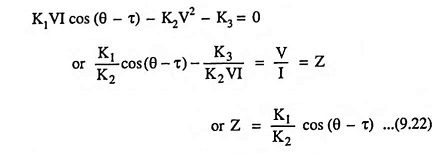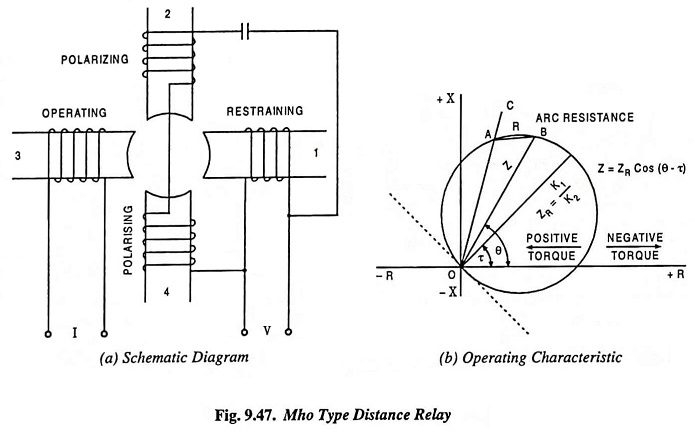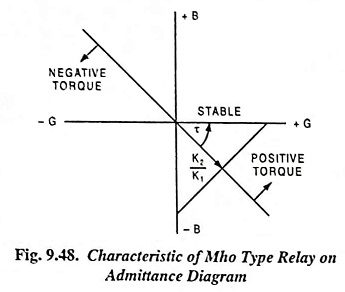Mho Type Distance Relay – Working and Characteristics:
Mho relay is a high speed relay and is also known as admittance relay. It is also sometimes called an angle impedance relay. In this Mho type distance relay operating torque is obtained by the volt-ampere element and the restraining torque is developed due to the voltage element. It means a mho relay is a voltage restrained directional relay.
A typical mho relay using induction cup structure is shown in Fig. 9.47 (a). The operating torque is developed by the interaction of fluxes due to poles 2, 3 and 4 and the restraining torque due to poles 1, 2 and 4.
If the spring control effect is indicated by – K3, the torque equation becomes
where
- θ and τ are defined as positive when I lags behind V
At balance point, the net torque is zero, and hence
if the spring control effect is neglected.
The above equation is similar to that of a directional relay when the control spring effect is taken into account but the difference is that there is no voltage term in the expression. Hence the relay has but one circular characteristic. The operating characteristic described by Eq. (9.22) is given in Fig. 9.47(b). The diameter of this circle is practically independent of V or I, except at very low magnitudes of current or voltage when the control spring effect is considered, which causes the diameter to decrease. The diameter of the circle is given as
The relay operates when the impedance seen by the relay falls within the circle. It is the fact that the circle passes through the origin which makes the relay inherently directional. The relay because of its inherently directional characteristic needs only one pair of contacts which makes it fast tripping for fault clearance and reduces the VA burden on the CTs. The impedance angle of the protected line is normally 60 to 70° which is shown by line OC in Fig. 9.47 (b). The arc resistance R, is represented by length AB which is horizontal to OC from the extremity of the chord Z. By making τ equal to, or little less lagging than θ, the circle is made to fit very closely around the faulty area so that the relay is insensitive to power swings and therefore particular applicable to the protection of long or heavily loaded lines.
The Eq. (9.22) can also be written as
where
- Y is the admittance in mho
For a given relay τ is constant, and the heads of the admittance phasor Y will lie on a straight line. The characteristic of Mho type distance relay on admittance diagram is, therefore, a straight line and is shown in Fig. 9.48.
Mho type distance relay is suitable for long EHV/UHV heavily loaded transmission lines as its threshold characteristic in Z-plane is a circle passing through the origin and its diameter is ZR i.e., K2/K1. Because of this, the threshold characteristic is quite compact enclosing fault area compactly and hence, there is lesser chance to operate during power swing and also it is directional.




